Interesting goodies from crystalinks.com
Ana
Winter Solstice - December 21
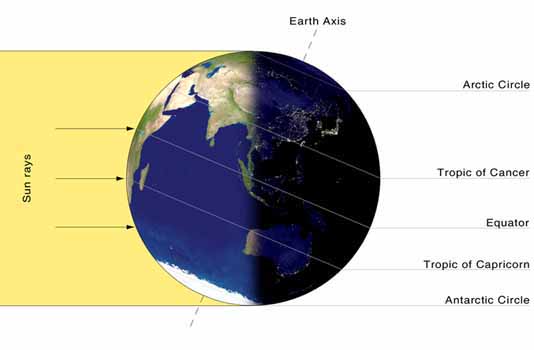
In astronomy, the winter solstice is the moment when the earth is at a
point in its orbit where one hemisphere is most inclined away from the
sun. This causes the sun to appear at its farthest below the celestial
equator when viewed from earth. Solstice is a Latin borrowing and means
"sun stand", referring to the appearance that the sun's noontime
elevation change stops its progress, either northerly or southerly. The
day of the winter solstice is the shortest day and the longest night of
the year.
In the northern hemisphere, the winter solstice usually falls on
December 21/December 22, which is the southern hemisphere's summer
solstice. At this time, the sun appears over the Tropic of Capricorn,
roughly 23.5 degrees South of the earth's equator. In the southern
hemisphere, winter solstice falls on June 21/June 22, which is the
northern hemisphere's summer solstice. At this time, the sun appears
over the Tropic of Cancer.
Since the winter solstice, summer solstice, vernal equinox, and autumnal
equinox were probably observed for the first time by people in the
northern hemisphere, these naming conventions originally corresponded to
the northern hemisphere's seasons. In most reckonings, the winter
solstice is midwinter. In Ireland's calendar, the solstices and
equinoxes all occur at about midpoint in each season. For example,
winter begins on November 1, and ends on January 31.
No one is really sure how long ago humans recognized the winter solstice
and began heralding it as a turning point -- the day that marks the
return of the sun to the northern hemisphere.
Many cultures the world over perform solstice ceremonies. At their root
-- an ancient fear that the failing light would never return unless
humans intervened with anxious vigil or antic celebration.
There's much new scholarship about Neolithic peoples and their amazing
culture. For example, it now looks as though writing is much more
ancient than we earlier thought -- as much as 10,000 years old.
Neolithic peoples were the first farmers. Their lives were intimately
tied to the seasons and the cycle of harvest - which would mean that
they were attuned to the movement of celestial objects and seasons.
Scholars have not as yet found proof, though, that these peoples had the
skill to pinpoint a celestial event like a solstice. Earliest markers
of time, found from these ancient peoples are notches carved into bone
that appear to count the cycles of the moon. But perhaps they watched
the movement of the sun as well as the moon, and perhaps they celebrated
it -- with fertility rites, with fire festivals, with offerings and
prayers to their gods and goddesses.
Most ancient cultures built Astronomical Observatories - tombs, temples, cairns among others, to align with the solstices and equinoxes.
Stonehenge - marker of the summer and winter solstices.
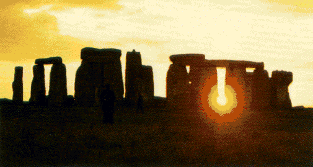
Newgrange

The passage and chamber of Newgrange are illuminated by the winter
solstice sunrise. A shaft of sunlight shines through the roof box over
the entrance and penetrates the passage to light up the chamber. The
dramatic event lasts for 17 minutes at dawn from the 19th to the 23rd of
December. The light illuminates a stone basin below intricate carvings
-- spirals, eye shapes, solar discs. Although not much is known about
how Newgrange was used by its builders, marking the solstice was
obviously of tremendous spiritual importance to them.
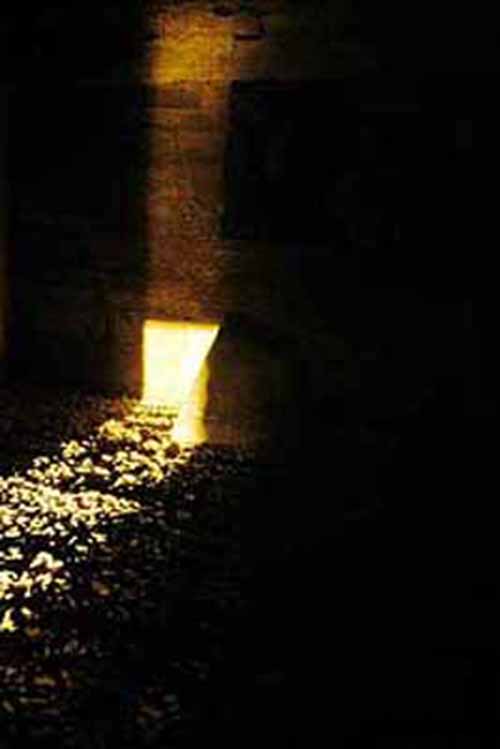
Maeshowe, on the Orkney Islands north of Scotland, shares a similar
trait, admitting the winter solstice setting sun. It is hailed as one of
the greatest architectural achievements of the prehistoric peoples of
Scotland.
Hundreds of other megalithic structures throughout Europe are oriented
to the solstices and the equinoxes. The blossoming field of
archaeoastronomy studies such sacred sites in the Americas, Asia,
Indonesia, and the Middle East.

Recent research into the medieval Great Zimbabwe in sub-Saharan Africa (also known as the "African Stonehenge") indicates a similar purpose.
In North America, one of the most famous such sites is the Sun Dagger of Chaco Canyon, New Mexico, built a thousand years ago by the Chacoans, ancestors of the Pueblo people.
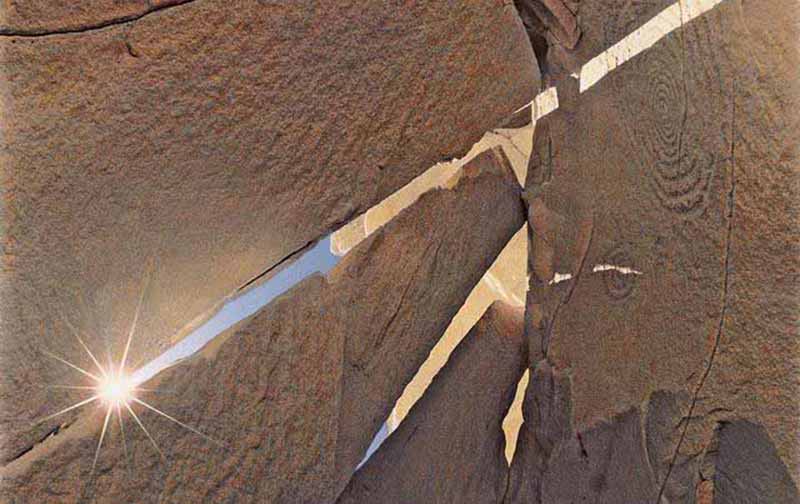
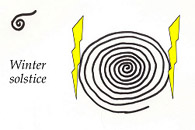
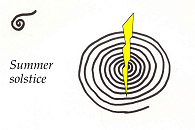
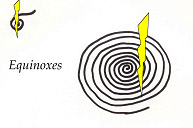

Even cultures that followed a moon-based calendar seemed also to
understand the importance of these sun-facing seasonal turning points.
The book, The Sun in the Church reveals that many medieval
Catholic churches were also built as solar observatories. The church,
once again reinforcing the close ties between religious celebration and
seasonal passages, needed astronomy to predict the date of Easter. And
so observatories were built into cathedrals and churches throughout
Europe. Typically, a small hole in the roof admitted a beam of sunlight,
which would trace a path along the floor. The path, called the meridian
line, was often marked by inlays and zodiacal motifs. The position at
noon throughout the year, including the extremes of the solstices, was
also carefully marked.
The winter solstice is the time when the Germanic festival of Yule was
celebrated; it is celebrated today as a Neopagan Sabbat. Christmas was
transplanted into winter solstice about 1,600 years ago, centuries
before the English language emerged from its Germanic roots.
Yule is the time of greatest darkness and the longest night of the year.
The Winter Solstice had been associated with the birth of a "Divine
King" long before the rise of Christianity. Since the Sun is considered
to represent the Male Divinity in many Pagan Traditions, this time is
celebrated as the "return of the Sun God" where He is reborn of the
Goddess.
Many cultures celebrate or celebrated a holiday near (within a few days)
the winter solstice; examples of these include Yalda, Saturnalia,
Christmas, Karachun, Hanukkah, Festivus, Kwanzaa, and Human Light. In
her fiction, Ursula K. Le Guin calls the solstice celebration "The
Festival of Sun Return".
Through an interesting coincidence in the Earth's orbit, the northern
hemisphere's winter occurs when the sun is actually closest to the
Earth. Conversely, the northern summer is when the sun is farthest from
the Earth. But the distance from the sun doesn't affect the seasons on
Earth to a measurable amount, since Earth's elliptical orbit is the
closest to circular of all of the planets in the solar system. In
general it's the angle of the sun's rays and the number of hours of
light per day that actually affects the seasons in most regions on the
planet.
Native Americans have winter solstice rites. The sun images at right are from rock
paintings of the Chumash, who occupied coastal California for thousands
of years before the Europeans arrived. Solstices were tremendously
important to them, and the winter solstice celebration lasted several
days.
In Iran, there is the observance of Yalda, in which families kept vigil
through the night and fires burned brightly to help the sun (and
Goodness) battle darkness (thought evil).
Winter solstice celebrations are also part of the cultural heritage of
Pakistan and Tibet. And in China, even though the calendar is based on
the moon, the day of winter solstice is called Dong Zhi, "The Arrival of
Winter." The cold of winter made an excellent excuse for a feast, so
that's how the Chinese observed it, with Ju Dong, "doing the winter." In
the Chinese calendar, the winter solstice is called "winter's extreme"
and is traditionally regarded as one of the year's most important
Jieqis, comparable to Chinese New Year.
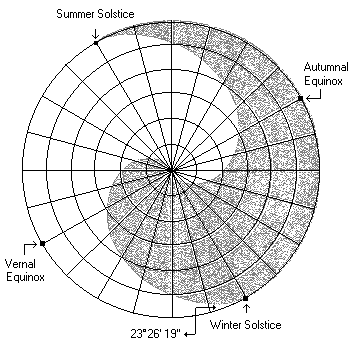
Yin/ Yang
The placement of Hanukah is tied to both the lunar and solar calendars. It begins on the 25th of
Kislev, three days before the new moon closest to the Winter Solstice.
It commemorates an historic event -- the Maccabees' victory over the
Greeks and the rededication of the temple at Jerusalem. But the form of
this celebration, a Festival of Lights (with candles at the heart of the
ritual), makes Hanukkah wonderfully compatible with other celebrations
at this time of year. As a symbolic celebration of growing light and as a
commemoration of spiritual rebirth, it also seems closely related to
other observances.
In many cultures, customs practiced at Christmas go back to pre-Christian times. Many involve divination -- foretelling
the future at a magic time -- the season turning of solstice.
In Russia, there's a Christmas divination that involves candles. A girl
would sit in a darkened room, with two lighted candles and two mirrors,
pointed so that one reflects the candlelight into the other. The viewer
would seek the seventh reflection, then look until her future would be
seen.
For ancient Germanic and Celtic people, the impulse to celebrate
solstice was the same as for their neighbors to the south -- a
celebration of the cycle of nature and a reaffirmation of the
continuation of life. But the style and substance of their celebrations
took very different shape.
The early Germans built a stone altar to Hertha, or Bertha, goddess of
domesticity and the home, during winter solstice. With a fire of fir
boughs stoked on the altar, Hertha was able to descend through the smoke
and guide those who were wise in Saga lore to foretell the fortunes of
those at the feast.
In Spain, there's an old custom that is a holdover from Roman days. The
urn of fate is a large bowl containing slips of paper on which are
written all the names of those at a family get-togehter. The slips of
paper are drawn out two at a time. Those whose names are so joined are
to be devoted friends for the year. Apparently, there's often a little
finagling to help matchmaking along, as well.
In Scandinavia, some families place all their shoes together, as this will cause them to live in harmony throughout the year.
And in many, many cultures, it's considered bad luck for a fire or a candle to go out on Christmas Day.
Four thousand years ago or so, ancient Egyptians celebrated the rebirth
of the sun at this time of year. They set the length of the festival at
12 days, to reflect the 12 divisions in their sun calendar. They
decorated with greenery, using palms with 12 shoots as a symbol of the
completed year, since a palm was thought to put forth a shoot each
month.
'Sacaea' was the Persian version. The annual renewal festival of the
Babylonians was adopted by the Persians. One of the themes of these
festivals was the temporary subversion of order. Masters and slaves
exchanged places. A mock king was crowned. Masquerades spilled into the
streets. As the old year died, rules of ordinary living were relaxed.
The Mesopotamians celebrated winter with a 12-day festival of renewal,
designed to help the god Marduk tame the monsters of chaos for one more
year.
The Egyptian and Persian traditions merged in ancient Rome, in a festival to the ancient god of seed-time, Saturn. The people gave themselves up to wild joy. They feasted, gave gifts,
and decorated their homes with greenery. The usual order of the year
was to let go of grudges and quarrels. Wars were interrupted or
postponed. Businesses, courts, schools closed. Rich and poor were equal,
slaves were served by masters, children headed the family.
Cross-dressing and masquerades, merriment of all kinds prevailed. A mock
king - the Lord of Misrule - was crowned. Candles and lamps chased away
the spirits of darkness. As Roman culture became more licentious, so
did Saturnalia. Over the years, it expanded to a whole week, the 17
December to 23 December.
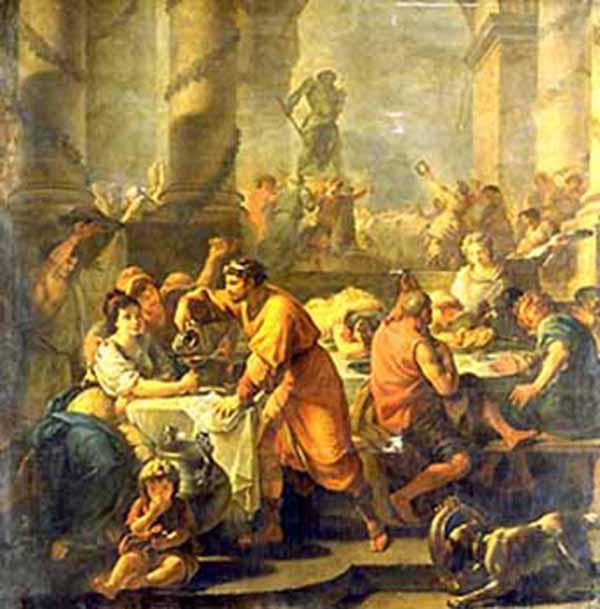
It also degenerated from mostly tomfoolery, marked chiefly by having
masters and slaves switch places, to sometimes debauchery, so that among
Christians the (lower case) word "saturnalia" came to mean "orgy".
It was traditional for Romans to exchange gifts during this holiday.
These gifts were customarily made of silver, although nearly anything
could be given as a gift for the occasion. Several epigrams by the poet
Martial survive, seemingly crafted as riddling gift-tags for gifts of
food.
Holy Blood, Holy Grail discusses the pragmatic political motives
of the fourth-century Roman emperor Constantine, who first moved the
celebration of Christmas to December 25. The authors claim that
Constantine followed the cult of Sol Invictus, a monotheistic
form of sun worship that originated in Syria and was imposed by Roman
emperors on their subjects a century earlier.
In the interests of unity, Constantine deliberately chose to blur the
distinctions among Christianity, Mithraism (another Sun cult of the
time) and Sol Invictus. This is the reason why Constantine decreed that
Sunday -- "the venerable day of the sun" would be the official day of
rest. Early Christians before that time celebrated their holy day on the
Jewish Sabbath, Saturday. By his edict, the book further claims, the
celebration of Jesus' birthday was moved from January 6th (Epiphany
today) to December 25, celebrated by the cult of Sol Invictus as Natilis
Invictus, the rebirth of the sun. The cult of Sol Invictus
(Unconquered Sun) was a comparatively late (3rd century BCE) arrival
from the East (Syria). It became the chief imperial cult of the Roman
Empire, until it was replaced by Christianity. In the old calendar the
winter solstice (Bruma = shortest [day]) fell on Dec. 25, so this was
the day on which Sol proved Himself to be yet unconquered.
The 12 Days of Christmas -- The midwinter festival of the ancient Egyptians celebrated the birth of Horus - son of Isis (the divine mother-goddess). The celebration was 12 days long,
reflecting their 12-month calendar. This concept took firm root in
many other cultures. In 567 AD, Christians adopted it. Church leaders
proclaimed the 12 days from December 25 to Epiphany as a sacred, festive
season.
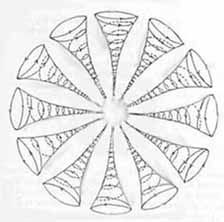
12 Around 1
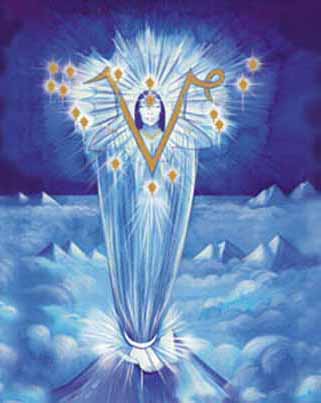
December 21 - Sun in Capricorn
Wednesday December 21, 2012
2012 Crystalinks
2012 Library of Halexandria
Mayan Calendar
Quetzalcoatl
The date December 21, 2012 AD (13.0.0.0.0 in the Long Count), represents
an extremely close conjunction of the Winter Solstice Sun with the
crossing point of the Galactic Equator (Equator of the Milky Way) and
the Ecliptic (path of the Sun), that ancient Maya recognized as the Sacred Tree. This is an event that has been coming to
resonance very slowly over thousands and thousands of years. It will
come to resolution at exactly 11:11 am GMT.



